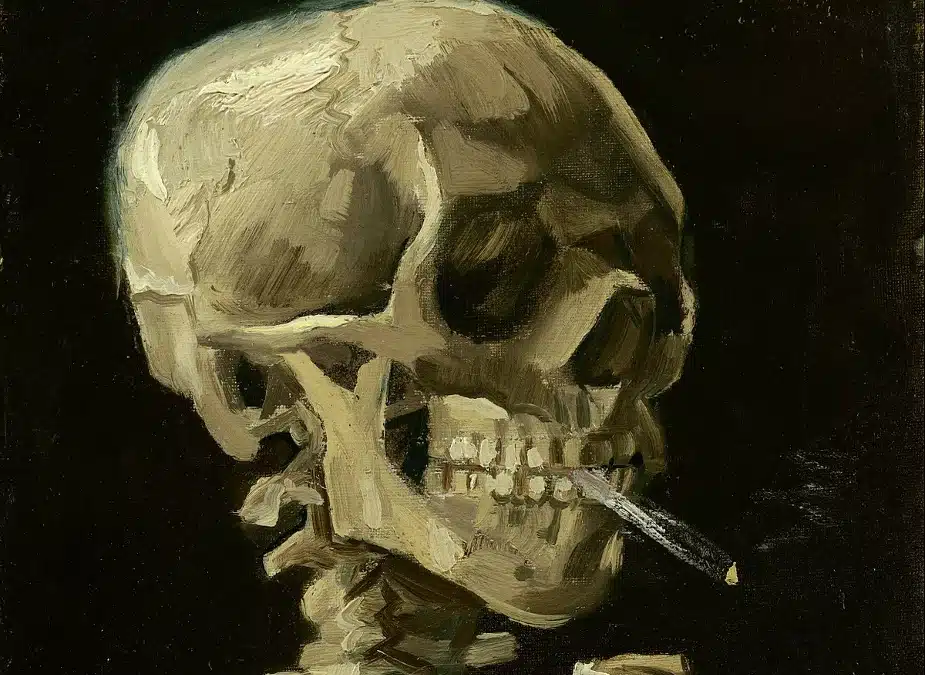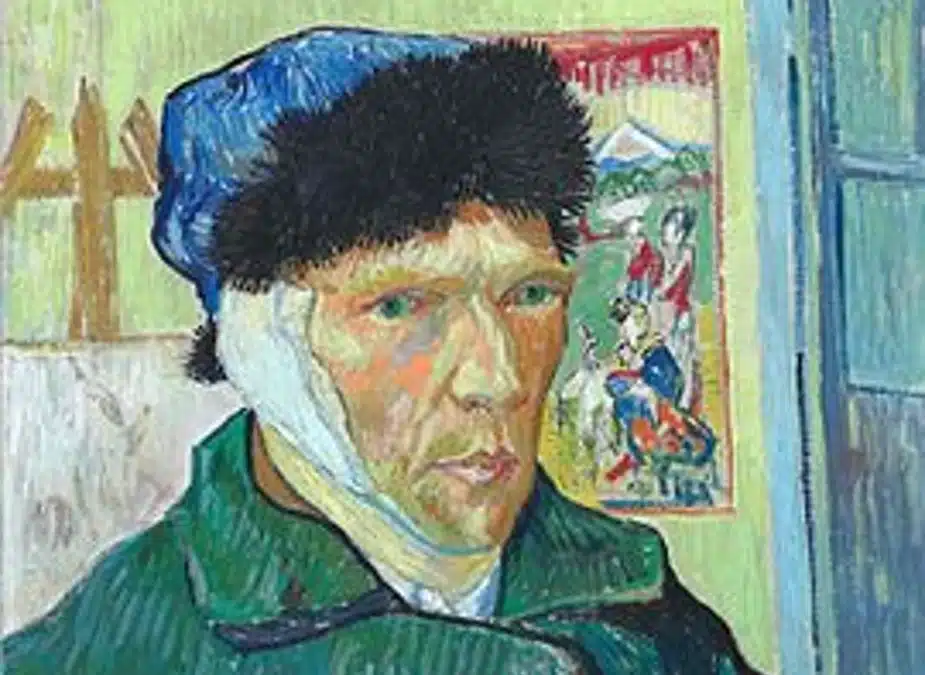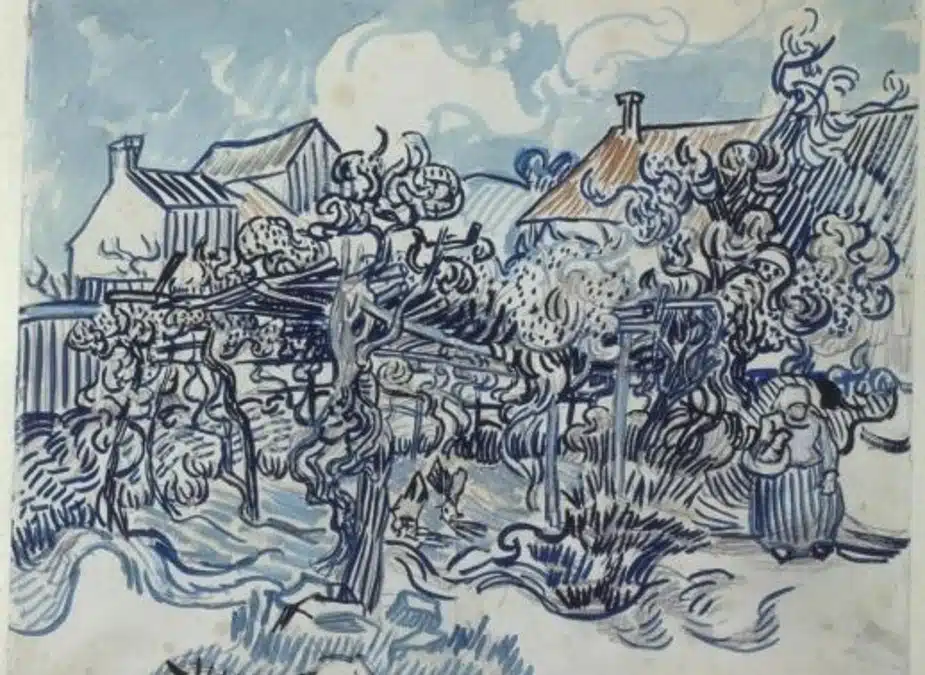When we think of the Van Gogh Museum, famous paintings like “ Starry Night” and “The Sunflowers” are the first to come to mind.
However, the museum has hidden gems that offer much more insights about the legendary painter beyond his masterworks.
From the head of a skeleton to a simplistic photo of shoes, these works offer tremendous insights into ideas, techniques, and personal stories.
This article will cover these hidden gems to showcase Van Gogh’s experiments with different themes and styles.
Exploring the Diverse World of Van Gogh’s Art
Let’s explore some of Van Gogh’s lesser-known works and their stories:
1. Head of a Skeleton with a Burning Cigarette (1886)

This eerie sketch is a part of the museum’s permanent collection.
The painting is oil on canvas, measuring 32 cm x 24.5 cm (12.6 in x 9.6 in).
The strong lines and dark shadows in the paintings represent satire on the conservative academic processes of that time.
Some also consider it a memento mori, which reflects the painter’s struggle with mental health issues.
2. Kingfisher by the Waterside (1887)
This painting, part of the museum’s permanent collection, was created between July and December 1886, during Van Gogh’s time in Paris.
The oil-on-canvas painting measured 19.0 x 26.5 cm and was left at his brother Theo Van Gogh’s apartment until he died in 1890.
The painting was later transferred to the Van Gogh Foundation by his widow, who gave it as a permanent loan to the Van Gogh Museum in 1994
It shows a river Kingfisher in its natural habitat, painted with vibrant colors and detailed brushwork.
This portrait testifies to Van Gogh’s love of nature and his skill in capturing it through his art.
3. Portrait of the Artist with Bandaged Ear (1889)

This self-portrait was made in December 1888, following a tough time in Van Gogh’s life.
In December 1888, he cut his left ear after a heated argument with fellow artist Paul Gauguin.
The oil-on-canvas painting measures 60 cm × 49 cm and has been part of the Van Gogh Museum’s permanent collection since 1994.
It is one of his famous works and is seen as a symbol of his struggles with mental illness
The character’s bandage depicts his pain, but his determined look tells us he will not give up.
This painting shows Van Gogh’s ability to capture the emotional depth of his experiences.
4. The Old Vineyard with Peasant Woman (1890)

This painting was created during his final days in Arles before his death in July 1890.
This oil-on-canvas painting measures 101.5 cm × 76.5 cm and is also part of the museum’s permanent collection
The scene shows a lonely woman in a big vineyard, evoking feelings of hardship and sadness.
Van Gogh’s skillful depiction of his emotional turmoil makes it a must-see for every art enthusiast.
5. Shoes (1886)
This painting was created during Van Gogh’s stay in Paris, from July to December 1886.
This oil-on-canvas painting measures 38.1 x 45.3 cm and is also part of the museum’s permanent collection
This simple painting of old shoes makes us feel sadness and hardship, while its thick paint and earthy colors remind us of hard times.
Each painting tells us something unique about Van Gogh’s life and how he felt.
Hidden Symbolism in Van Gogh’s Art
Van Gogh’s work is characterized by hidden symbolism, adding layers of meaning to his creations.
Crows symbolize sadness and despair, while sunflowers represent joy and happiness.
There are details in his brushwork as well, where he used dark lines and bright colors to express emotions and ideas.
From exploring the cycles of life and death to diving into his psyche, Van Gogh’s art transcends the surface into a deeply felt inner world.
How do you find these hidden gems?
The museum weaves masterpieces such as Starry Night and the Sunflowers along with lesser-known gems to create a compilation of Van Gogh’s journey.
Consider these tips to locate these treasures efficiently:
Use Maps
The museum provides detailed maps highlighting the lesser-known paintings and special exhibits.
Maps further aid in navigation by providing information about the stairs, rooms, and directions.
Take a guided tour
If you want to see all of the treasures without missing anything, take a guided tour.
You can get guides in your preferred languages. As you explore the museum, they will tell you about all the hidden gems and the stories associated with them.
Enquire with the Staff
Remember that the museum staff is extremely helpful and here to help you.
Do not hesitate to ask questions. They can also give you tips on exploring the museum’s hidden areas.
Why do these hidden treasures matter?
Exploring these treasures will let you gain a deeper understanding of the artist’s life, growth, and unique perspective.
You will understand the emotions that fueled his creativity while analyzing his evolution as an artist.
These gems will let you experience his experiments with different styles and techniques and his struggles and triumphs.
These works will remind you that even a famous artist like Van Gogh has hidden layers, waiting to be discovered.
FAQs
1. Are there any hidden or lesser-known events or exhibitions at the Van Gogh Museum?
The museum frequently hosts special exhibitions and events, such as the annual Van Gogh Gala and the Van Gogh Reads series.
These events aim to explore the links between Van Gogh’s art and literature.
2. Are there any hidden gems in the Van Gogh Museum building itself?
Even though the museum’s collection is more well-known than its architecture, the structure is still a work of art.
Notice the eye-catching atrium made of glass and the rooftop terrace with its expansive views of Amsterdam.
3. Are there any hidden details or techniques to look for in Van Gogh’s paintings?
Yes, you should examine the brushwork closely to see the evolution of Van Gogh’s unique style.
You can see the depth and texture of his paintings thanks to the lighting in the museum.
4. Are there any hidden meanings or symbolism in Van Gogh’s paintings at the museum?
Look for recurring themes such as sunflowers, which symbolize love and friendship, or the night sky, which symbolizes Van Gogh’s fascination with the universe.
The museum’s wall texts also provide insights into the hidden meanings in his work.
5. What are some of the most underrated or overlooked works in the Van Gogh collection?
Do not miss lesser-known treasures like Skull of a Skeleton with Burning Cigarette or Worn Out, an eerie portrait of an elderly man.
These pieces demonstrate Van Gogh’s technical mastery and gloomy sense of humor.
Featured Image : Image: Vangoghmuseum.nl|Image: Wikipedia.org|Image: Wikipedia.org




